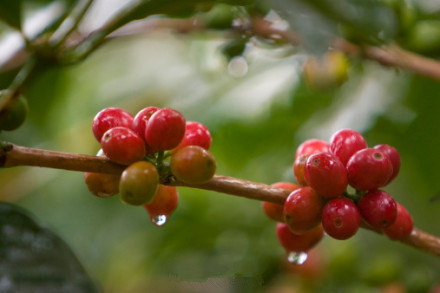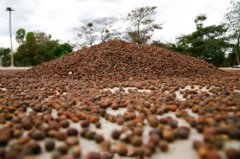Understand that coffee trees are evergreen shrubs or trees belonging to Rubiaceae.

1 Coffee tree
Coffee trees are evergreen shrubs or trees belonging to the Rubiaceae family. Wild coffee trees can grow to a height of 5 to 10 meters, but coffee trees planted in the manor are often cut to a height of less than 2 meters in order to increase fruit and facilitate harvesting. Coffee tree opposite leaves are long oval, smooth leaves, the end of the branch is very long, few branches, and the flowers are white, open at the base of the petiole connecting the branch. The ripe coffee berries look like cherries and are bright red with sweet flesh and contain a pair of seeds, namely coffee beans (Coffee Beans).
Arabica bean coffee trees can be divided into two main varieties: Arabica (Coffea Arabica) and Robusta (Coffea Robusta/Coffea Canephora). In addition, there are some minor species, such as Coffea Liberica and Coffea Arabusta, but they are rare on the market.
Robusta beans Robusta coffee trees can grow on flat land, it has a strong resistance to disease, and the yield is higher. Compared with Arabica beans, Robusta beans are more round in appearance, with a slightly inflated side with cracks in the middle, and straight grooves reminiscent of soybeans, while Arabica beans are oval and zigzag, a bit like half a peanut.
Generally speaking, Robusta beans are poor in taste, have 2 to 3 times the caffeine content of Arabica beans, and are cheap, mostly for the large coffee industry to produce instant coffee or low-cost comprehensive products. The coffee trees planted in Arabica are suitable for planting on fertile hillsides with good drainage at an altitude of about 1,000 to 2,000 meters. The climate for growth should not be too humid, but it still requires a continuous rainy season and abundant rainfall.
During the day, they like mild but not very hot temperatures and less than two hours of direct sunshine, so if they lack the afternoon showers or thick fog to report every day, local farmers have to plant many taller trees in the coffee garden for shade. At night, they want an environment of about 10 degrees Celsius, but the temperature should not be too low, because too warm will make the coffee berries grow too fast to produce small, strong, hard and high-quality coffee beans. If it is too cold to frost, the coffee trees will freeze to death.
Based on these characteristics, the promised land suitable for Arabica coffee growth is mostly located in countries with alpine terrain between the Tropic of Cancer and the Tropic of Cancer, which is also known as the coffee belt (Coffee Zone/Coffee belt).
Important Notice :
前街咖啡 FrontStreet Coffee has moved to new addredd:
FrontStreet Coffee Address: 315,Donghua East Road,GuangZhou
Tel:020 38364473
- Prev

Composition Analysis of Coffee beans basic knowledge of Coffee
Fat: there are many kinds of fat in coffee, the most important of which are acidic fat and volatile fat; acidic fat refers to the presence of acid in fat, and its acidity varies with different types of coffee. Volatile fat is the main source of coffee aroma, emitting 40 aromatic substances, is a very complex and subtle ingredient. Sugar: coffee beans contain about 8% sugar
- Next

Understand that coffee beans grow around the equator
Coffee beans grow in tropical or subtropical agricultural gardens centered around the equator called coffee belts and travel to Japan with ships. When the brown coffee beans appear in front of your eyes, they have actually gone through a variety of different circulation processes and the hands of many people. Coffee is widely distributed in South America, Central America, the West Indies, Asia, Africa, Arabia,
Related
- Beginners will see the "Coffee pull flower" guide!
- What is the difference between ice blog purified milk and ordinary milk coffee?
- Why is the Philippines the largest producer of crops in Liberia?
- For coffee extraction, should the fine powder be retained?
- How does extracted espresso fill pressed powder? How much strength does it take to press the powder?
- How to make jasmine cold extract coffee? Is the jasmine + latte good?
- Will this little toy really make the coffee taste better? How does Lily Drip affect coffee extraction?
- Will the action of slapping the filter cup also affect coffee extraction?
- What's the difference between powder-to-water ratio and powder-to-liquid ratio?
- What is the Ethiopian local species? What does it have to do with Heirloom native species?

